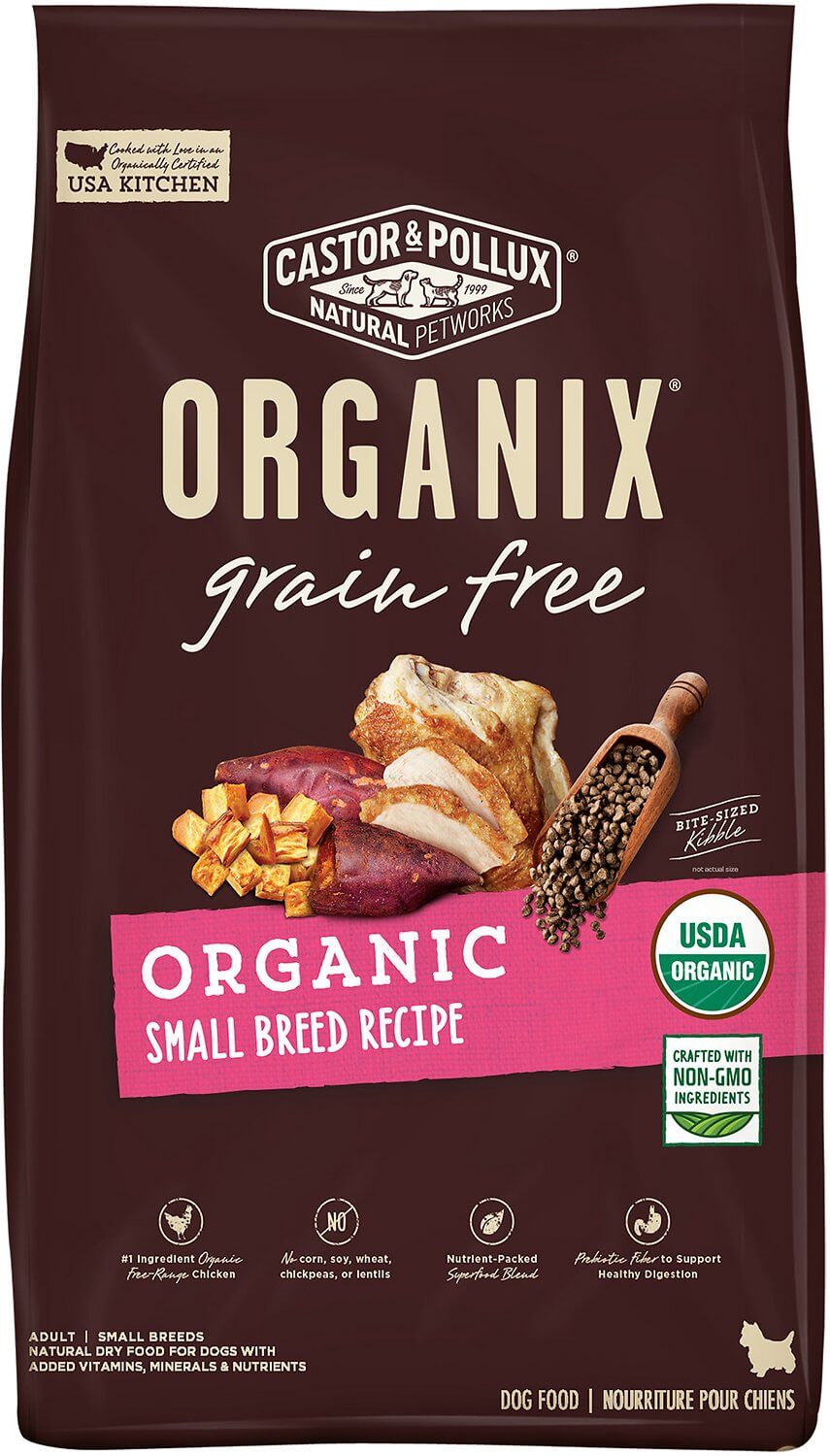
DogFoodAdvisor is reader supported See how
All reviews are 100% impartial but if you buy using links on this page, we may earn a referral fee.
Product May Have Been Discontinued
Unable to Locate Complete Label Info
On Company Website1
Which Castor and Pollux Organix Grain Free Dry Recipes Get Our Best Ratings?
Castor and Pollux Organix Grain Free Dog Food receives the Advisor’s top rating of 5 stars.
The Castor and Pollux Organix Grain Free product line includes the 2 dry dog foods listed below.
Each recipe includes its AAFCO nutrient profile when available… Growth (puppy), Maintenance (adult), All Life Stages, Supplemental or Unspecified.
| Product | Rating | AAFCO |
|---|---|---|
| Organix Grain Free Small Breed | 5 | M |
| Organix Grain Free Chicken and Sweet Potato | 5 | M |
Recipe and Label Analysis
Castor and Pollux Organix Grain Free Small Breed was selected to represent both products in the line for detailed recipe and nutrient analysis.
Label and nutrient data below are calculated using dry matter basis.
Castor and Pollux Organix Grain Free Small Breed
Estimated Dry Matter Nutrient Content
Protein
Fat
CarbsCarbohydrates
Organic chicken, organic chicken meal, organic sweet potatoes, organic potatoes, organic peas, organic tapioca, organic chicken fat, organic sunflower seed meal, organic pea protein, organic flaxseed, natural flavor, organic sunflower oil, organic chicken liver, organic blueberries, organic chicory root (source of inulin), salt, vitamins (vitamin E supplement, niacin supplement, thiamine mononitrate, d-calcium pantothenate, vitamin A supplement, pyridoxine hydrochloride, riboflavin supplement, vitamin D3 supplement, biotin, vitamin B12 supplement, folic acid), minerals (zinc methionine complex, calcium carbonate, zinc sulfate, iron proteinate, ferrous sulfate, copper proteinate, copper sulfate, manganese proteinate, sodium selenite, manganous oxide, calcium iodate, ethylenediamine dihydroiodide), choline chloride, taurine, potassium chloride, organic amaranth, mixed tocopherols for freshness, dried Bacillus coagulans fermentation productanic rosemary extract
Fiber (estimated dry matter content) = 3.5%
Red denotes any controversial items
| Estimated Nutrient Content | |||
|---|---|---|---|
| Method | Protein | Fat | Carbs |
| Guaranteed Analysis | 26% | 15% | NA |
| Dry Matter Basis | 29% | 17% | 46% |
| Calorie Weighted Basis | 25% | 35% | 40% |
Ingredient Analysis
The first ingredient in this dog food is chicken. Although it is a quality item, raw chicken contains up to 73% water. After cooking, most of that moisture is lost, reducing the meat content to just a fraction of its original weight.
After processing, this item would probably account for a smaller part of the total content of the finished product.
The second ingredient is chicken meal. Chicken meal is considered a meat concentrate and contains nearly 300% more protein than fresh chicken.
The third ingredient includes sweet potato. Sweet potatoes are a gluten-free source of complex carbohydrates in dog food. They are naturally rich in dietary fiber and beta carotene.
The fourth ingredient is potato. Potatoes can be considered a gluten-free source of digestible carbohydrates. Yet with the exception of perhaps their caloric content, potatoes are of only modest nutritional value to a dog.
The fifth ingredient includes peas, which are a quality source of carbohydrates. And like all legumes, they’re rich in natural fiber. However, peas contain about 25% protein.
The sixth ingredient is tapioca, a gluten-free, starchy carbohydrate extract made from the root of the cassava plant.
The next ingredient is chicken fat. This item is obtained from rendering chicken, a process similar to making soup in which the fat itself is skimmed from the surface of the liquid.
Chicken fat is high in linoleic acid, an omega-6 fatty acid essential for life. Although it doesn’t sound very appetizing, chicken fat is actually a quality ingredient.
The eighth item is sunflower seed meal, a by-product of the oil extraction process – and an item more typically found in feed for livestock.
Although sunflower meal contains about 34% protein, it would be expected to have a lower biological value than meat.
And less costly plant-based products like this can notably boost the total protein reported on the label — a factor that must be considered when judging the actual meat content of this dog food.
The ninth ingredient is pea protein, what remains of a pea after removing the starchy part of the vegetable.
Even though it contains over 80% protein, this ingredient would be expected to have a lower biological value than meat.
And less costly plant-based products like this can notably boost the total protein reported on the label — a factor that must be considered when judging the meat content of this dog food.
From here, the list goes on to include a number of other items.
But to be realistic, ingredients located this far down the list (other than nutritional supplements) are not likely to affect the overall rating of this Castor and Pollux product.
With 6 notable exceptions…
First, this recipe includes flaxseed, one of the best plant sources of healthy omega-3 fatty acids. Provided they’ve first been ground into a meal, flax seeds are also rich in soluble fiber.
However, flaxseed contains about 19% protein, a factor that must be considered when judging the actual meat content of this dog food.
Next, we find sunflower oil. Sunflower oil is nutritionally similar to safflower oil. Since these oils are high in omega-6 fatty acids and contain no omega-3’s, they’re considered less nutritious than canola or flaxseed oils.
Sunflower oil is notable for its resistance to heat damage during cooking.
There are several different types of sunflower oil, some better than others. Without knowing more, it’s impossible to judge the quality of this ingredient.
In addition, chicory root is rich in inulin, a starch-like compound made up of repeating units of carbohydrates and found in certain roots and tubers.
Not only is inulin a natural source of soluble dietary fiber, it’s also a prebiotic used to promote the growth of healthy bacteria in a dog’s digestive tract.
We also note the use of taurine, an important amino acid associated with the healthy function of heart muscle. Although taurine is not typically considered essential in canines, some dogs have been shown to be deficient in this critical nutrient.
Since taurine deficiency appears to be more common in pets consuming grain-free diets, we view its presence in this recipe as a positive addition.
Next, we find sodium selenite, a controversial form of the mineral selenium in this product. Sodium selenite appears to be nutritionally inferior to the more natural source of selenium found in selenium yeast.
And lastly, this food contains chelated minerals, minerals that have been chemically attached to protein. This makes them easier to absorb. Chelated minerals are usually found in better dog foods.
Nutrient Analysis
Since this recipe contains a number of organic ingredients, we feel compelled to grant this line a more favorable status as we consider its final rating.
That’s because organic ingredients must comply with notably more stringent government standards — standards which significantly restrict the use of any synthetic pesticides, herbicides, insecticides, hormones or antibiotics.
With that in mind…
Based on its ingredients alone, Castor and Pollux Organix Grain Free Dog Food looks like an above-average dry product.
The dashboard displays a dry matter protein reading of 29%, a fat level of 17% and estimated carbohydrates of about 46%.
As a group, the brand features an average protein content of 29% and a mean fat level of 17%. Together, these figures suggest a carbohydrate content of 46% for the overall product line.
And a fat-to-protein ratio of about 58%.
Which means this Castor and Pollux product line contains…
Above-average protein. Near-average fat. And below-average carbs when compared to other dry dog foods.
Even when you consider the protein-boosting effect of the peas, pea protein, sunflower seed meal and flaxseed, this looks like the profile of a kibble containing a notable amount of meat.
Our Rating of Castor and Pollux Organix Grain Free Dry Dog Food
Castor and Pollux Organix Grain Free is a dry dog food using a notable amount of named meat meal as its dominant source of animal protein. The Dog Food Advisor awards this brand 5 stars.
Enthusiastically recommended.
More Top Picks
Castor and Pollux Dog Food Recall History
The following automated list (if present) includes all dog food recalls related to Castor and Pollux through March.
No recalls noted.
You can view a complete list of all dog food recalls since 2009 here.
Get Free Recall Alerts
Get free dog food recall alerts sent to you by email. Subscribe to The Advisor’s recall notification list.
More Castor and Pollux Brand Reviews
The following Castor and Pollux dog food reviews are also posted on this website:
Compare This Dog Food
How does this brand compare with The Dog Food Advisor's most recommended brands?
Sources
A Final Word
The Dog Food Advisor does not accept money, gifts, samples or other incentives in exchange for special consideration in preparing our reviews.
However, we do receive a referral fee from online retailers (like Chewy or Amazon) and from sellers of perishable pet food when readers click over to their websites from ours. This helps cover the cost of operation of our free blog. Thanks for your support.
For more information, please visit our Disclaimer and Disclosure page.







